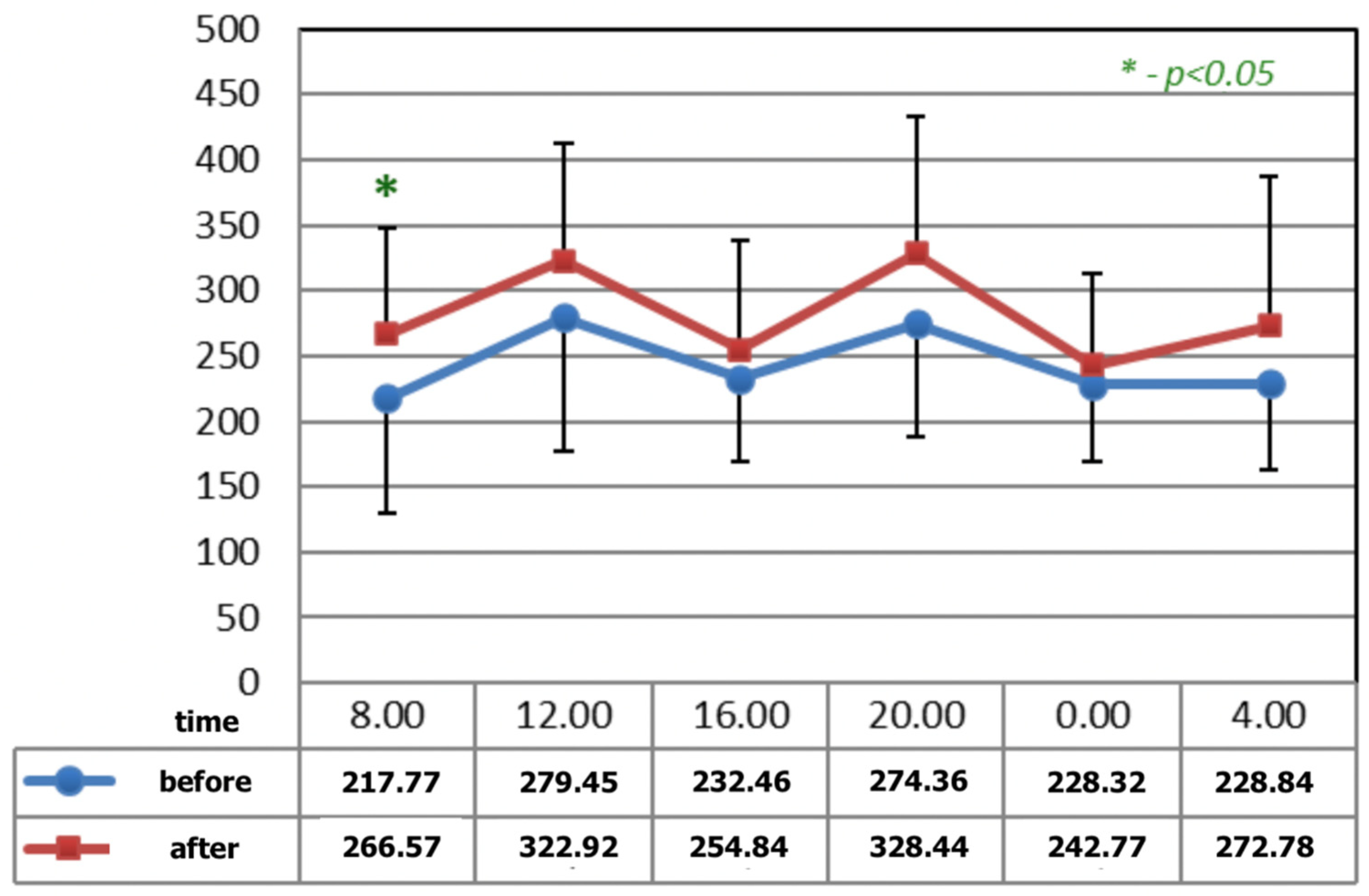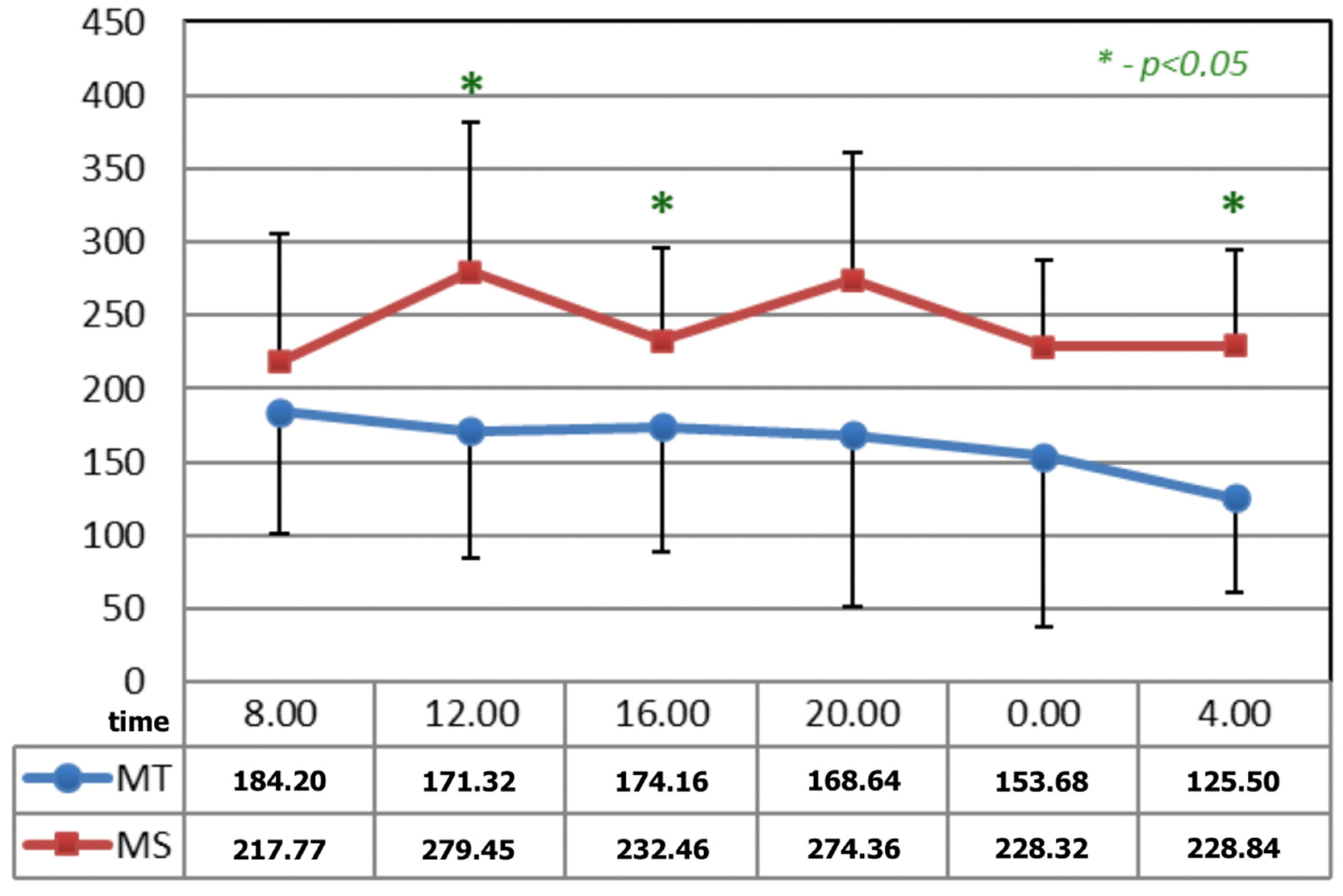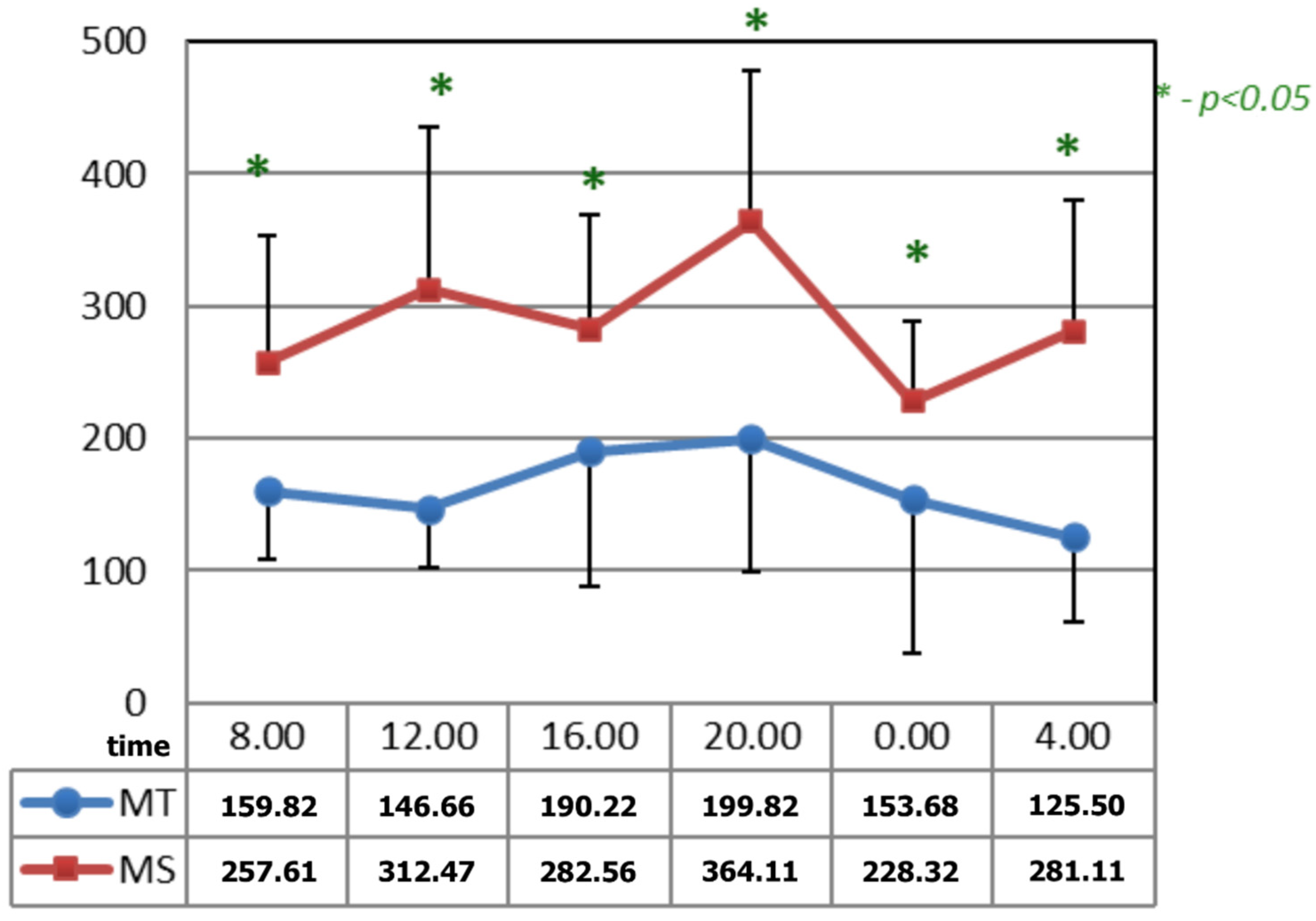Chronic-Exposure Low-Frequency Magnetic Fields (Magnetotherapy and Magnetic Stimulation) Influence Serum Serotonin Concentrations in Patients with Low Back Pain—Clinical Observation Study
Abstract
1. Introduction
2. Materials and Methods
2.1. Study Population
- -
- Men aged 18–60 years with LBP;
- -
- The men did not suffer from any diseases of the digestive system, circulatory system, metabolism, or hormonal disorders;
- -
- Not taking any medications;
- -
- No contraindications to the therapy from other systems;
- -
- Consent to examination procedures;
- -
- Contraindications to the use of a magnetic field;
- -
- Lack of consent of the patient and the guardian to examinations and participation in the program.
2.2. Study Protocol—Magnetic Fields
2.3. Study Protocol—Blood Analysis
2.4. Data Analysis
3. Results
4. Discussion
5. Conclusions
- Working similarly, magnetotherapy and magnetic stimulation raise the concentrations of serotonin. However, it seems that magnetic stimulation is more effective in this respect.
- Weak magnetic fields produce similar effect to the stronger ones that are used in TMS.
- It is possible to use magnetotherapy and magnetic stimulation in the treatment of mental illnesses or in the diseases of the neuromuscular system, as well as in other illnesses that are characterized by a low concentration of serotonin.
Author Contributions
Funding
Institutional Review Board Statement
Informed Consent Statement
Conflicts of Interest
References
- David, C.; Aron, D.C.; Findling, J.W.; Tyrell, J.B. Hypothalamus and Pituitary Gland. In Basic and Clinical Endocrinology; Greenspan, F.S., Gardner, D.G., Eds.; “Czelej” Publishing House: Lublin, Poland, 2004; pp. 114–172. (In Polish) [Google Scholar]
- Słomiński, A.; Wortsman, J.; Tobin, D.J. The cutaneous serotonergic/malatoninergic system; securing a place dunder the sun. FASEB J. 2005, 19, 176–194. [Google Scholar] [CrossRef] [PubMed]
- Lee, S.; Seol, H.-S.; Eom, S.; Lee, J.; Kim, C.; Park, J.-H.; Kim, T.-H.; Lee, J.H. Hydroxy Pentacyclic Triterpene Acid, Kaempferol, Inhibits the Human 5-Hydroxytryptamine Type 3A Receptor Activity. Int. J. Mol. Sci. 2022, 23, 544. [Google Scholar] [CrossRef] [PubMed]
- Blier, P.; Gobbi, G.; Haddjeri, N.; Santarelli, L.; Mathew, G.; Hen, R. Impact of substance P receptor antagonism on the serotonin and norepinephrine systems: Relevance to the antidepressant/anxiolytic response. J. Psychiatry Neurosci. 2004, 29, 208–218. [Google Scholar] [PubMed]
- Hajihasani, A.; Rouhani, M.; Salavati, M.; Hedayati, R.; Kahlaee, A.H. The Influence of Cognitive Behavioral Therapy on Pain, Quality of Life, and Depression in Patients Receiving Physical Therapy for Chronic Low Back Pain: A Systematic Review. PM&R 2019, 11, 167–176. [Google Scholar] [CrossRef]
- Gupta, S.; Wang, M.; Azuma, Y.; Muma, N.A. Regulation of Serotonin 1A Receptor SUMOylation by SENP2 and PIASxα. Int. J. Mol. Sci. 2021, 22, 13176. [Google Scholar] [CrossRef] [PubMed]
- E Ferreira, G.; McLachlan, A.J.; Lin, C.-W.C.; Zadro, J.R.; Abdel-Shaheed, C.; O’Keeffe, M.; Maher, C.G. Efficacy and safety of antidepressants for the treatment of back pain and osteoarthritis: Systematic review and meta-analysis. BMJ 2021, 372, m4825. [Google Scholar] [CrossRef] [PubMed]
- Mohammad-Zadeh, L.F.; Moses, L.; Gwaltney-Brant, S.M. Serotonin: A review. J. Veter.-Pharmacol. Ther. 2008, 31, 187–199. [Google Scholar] [CrossRef] [PubMed]
- Woldańska-Okońska, W.; Czernicki, J. Analgesic effects of magnetic fields of different characteristics. Acta Bio–Optica Inform. Med. 2002, 8, 5–9. (In Polish) [Google Scholar]
- Correia, A.; Cardoso, A.; Vale, N. Highlighting Immune System and Stress in Major Depressive Disorder, Parkinson’s, and Alzheimer’s Diseases, with a Connection with Serotonin. Int. J. Mol. Sci. 2021, 22, 8525. [Google Scholar] [CrossRef]
- Marktl, W.; Brugger, P.; Herold, M. Melatonin and coronary heart disease. Wien. Klin. Wochenschr. 1997, 109, 747–749. [Google Scholar]
- Fouquet, G.; Coman, T.; Hermine, O.; Côté, F. Serotonin, hematopoiesis and stem cells. Pharmacol. Res. 2019, 140, 67–74. [Google Scholar] [CrossRef]
- Van Dam, F. The influence of neurotransmitters on the development of the brain. Selected problems of paediatric rehabilitation. In Wojewódzki Szpital Rehabilitacyjny dla Dzieci w Ameryce i SPW Edycja; Kowalski, I.M.W., Lewandowski, R., Eds.; Ameryka: Olsztyn, Poland, 2005; pp. 28–31. (In Polish) [Google Scholar]
- Cañedo, L.; Cantú, R.; Hernández-R, J. Magnetic field exposure during gestation: Pineal and cerebral cortex serotonin in the rat. Int. J. Dev. Neurosci. 2003, 21, 263–266. [Google Scholar] [CrossRef]
- Geldenhuys, W.J.; Van Der Schyf, C.J. Role of Serotonin in Alzheimer’s Disease: A new therapeutic target? CNS Drugs 2011, 25, 765–781. [Google Scholar] [CrossRef] [PubMed]
- Daut, R.A.; Fonken, L.K. Circadian regulation of depression: A role for serotonin. Front. Neuroendocr. 2019, 54, 100746. [Google Scholar] [CrossRef] [PubMed]
- Nonogaki, K. The Regulatory Role of the Central and Peripheral Serotonin Network on Feeding Signals in Metabolic Diseases. Int. J. Mol. Sci. 2022, 23, 1600. [Google Scholar] [CrossRef] [PubMed]
- Woldańska-Okońska, M.; Czernicki, J.; Karasek, M. The influence of the low-frequency magnetic fields of different parameters on the secretion of cortisol in men. Int. J. Occup. Med. Environ. Health 2013, 26, 92–101. [Google Scholar] [CrossRef]
- Kanno, M.; Matsumoto, M.; Togashi, H.; Yoshioka, M.; Mano, Y. Effects of acute repetitive transcranial magnetic stimulation on extracellurar serotonin concentration in the rat prefrontal cortex. J. Pharmacol. Sci. 2003, 93, 451–457. [Google Scholar] [CrossRef][Green Version]
- Keck, M.E.; Welt, T.; Müller, M.B.; Toschi, N.; Wigger, A.; Landgraf, R.; Holsboer, F.; Engelmann, M. Neuroendocrine and behavioral effects of repetitive transcranial magnetic stimulation in a psychopathological animal model are suggestive of an-tidepressant-like effects. Neuropsychopharmacology 2001, 24, 337–349. [Google Scholar] [CrossRef]
- Lerchl, A.; Nonaka, K.O.; Stokkan, K.-A.; Reiter, R.J. Marked rapid alterations in nocturnal pineal serotonin metabolism in mice and rats exposed to weak intermittent magnetic fields. Biochem. Biophys. Res. Commun. 1990, 169, 102–108. [Google Scholar] [CrossRef]
- Reiter, R.J. Static and extremely low frequently electromagnetic field exposure: Reported effects on the circadian production of melatonin. J. Cell Biochem. 1993, 51, 394–403. [Google Scholar] [CrossRef] [PubMed]
- Sieroń, A.; Labus, L.; Nowak, P.; Cieślar, G.; Brus, H.; Durczok, A.; Zagzil, T.; Kostrzewa, R.M.; Brus, R. Alternating extremely low frequency magnetic field increases turnover of dopamine and serotonin in rat frontal cortex. Bioelectromagnetics 2004, 25, 426–430. [Google Scholar] [CrossRef]
- Sandyk, R. Treatment with Weak Electromagnetic Fields Attenuates Carbohydrate Craving in a Patient with Multiple Sclerosis. Int. J. Neurosci. 1996, 86, 67–77. [Google Scholar] [CrossRef]
- Sandyk, R. Suicidal behaviour is attenuated in patients with multiple sclerosis by treatment with electromagnetic fields. Int. J. Neurosci. 1996, 87, 5–15. [Google Scholar] [CrossRef]
- Sieroń, A.; Hese, R.T.; Sobiś, J.; Cieślar, G. Therapeutic efficacy assessment of weak variable magnetic fields with low value of induction in patients with depression disorders. Psych. Pol. 2004, 37, 217–225. (In Polish) [Google Scholar]
- Babych, V.I. Serotonin metabolism under the action of a low geomagnetic field. Fiziolohichnyĭ Zhurnal 1996, 42, 79–82. [Google Scholar]
- Welker, H.A.; Semm, P.; Willig, R.P.; Commentz, J.C.; Wiltschko, W.; Vollrath, L. Effects of an artificial magnetic field on serotonin N-acetyltransferase activity and melatonin content of the rat pineal gland. Exp. Brain Res. 1983, 50, 426–432. [Google Scholar] [CrossRef]
- Burchard, J.F.; Nguyen, D.H.; Richard, L.; Young, S.N.; Heyes, M.P.; Block, E. Effects of electromagnetic fields on the levels of biogenic amine metabolites, quinilinic acid, and beta-endorphin in the cerebrospinal fluid of dairy cows. Neurochem. Res. 1998, 23, 1527–1531. [Google Scholar] [CrossRef] [PubMed]
- Laporte, R.; Kus, L.; Wisniewski, R.A.; Prechel, M.M.; Azar-Kia, B.; McNulty, J.A. Magnetic resonance imaging (MRI) effects on rat pineal neuroendocrine function. Brain Res. 1990, 506, 294–296. [Google Scholar] [CrossRef]
- Kroeker, G.; Parkinson, D.; Vriend, J.; Peeling, J. Neurochemical effects of static magnetic fields exposure. Surg. Neurol. 1996, 45, 62–66. [Google Scholar] [CrossRef]
- Karasek, M.; Czernicki, J.; Woldańska-Okońska, M.; Żylińska, K.; Świętosławski, J. Chronic exposure 25–80 μT, 200 Hz magnetic field does not influence serum melatonin concentrations in patients with low back pain. J. Pineal Res. 2000, 29, 81–85. [Google Scholar] [CrossRef] [PubMed]
- Shafiee, S.; Hasanzadeh Kiabi, F.; Shafizad, M.; Emami Zeydi, A. Repetitive transcranial magnetic stimulation: A potential therapeutic modality for chronic low back pain. Korean J. Pain 2017, 30, 71–72. [Google Scholar] [CrossRef] [PubMed]
- Yang, S.; Chang, M.C. Effect of Repetitive Transcranial Magnetic Stimulation on Pain Management: A Systematic Narrative Review. Front. Neurol. 2020, 11, 114. [Google Scholar] [CrossRef] [PubMed]




Publisher’s Note: MDPI stays neutral with regard to jurisdictional claims in published maps and institutional affiliations. |
© 2022 by the authors. Licensee MDPI, Basel, Switzerland. This article is an open access article distributed under the terms and conditions of the Creative Commons Attribution (CC BY) license (https://creativecommons.org/licenses/by/4.0/).
Share and Cite
Woldańska-Okońska, M.; Koszela, K. Chronic-Exposure Low-Frequency Magnetic Fields (Magnetotherapy and Magnetic Stimulation) Influence Serum Serotonin Concentrations in Patients with Low Back Pain—Clinical Observation Study. Int. J. Environ. Res. Public Health 2022, 19, 9743. https://doi.org/10.3390/ijerph19159743
Woldańska-Okońska M, Koszela K. Chronic-Exposure Low-Frequency Magnetic Fields (Magnetotherapy and Magnetic Stimulation) Influence Serum Serotonin Concentrations in Patients with Low Back Pain—Clinical Observation Study. International Journal of Environmental Research and Public Health. 2022; 19(15):9743. https://doi.org/10.3390/ijerph19159743
Chicago/Turabian StyleWoldańska-Okońska, Marta, and Kamil Koszela. 2022. "Chronic-Exposure Low-Frequency Magnetic Fields (Magnetotherapy and Magnetic Stimulation) Influence Serum Serotonin Concentrations in Patients with Low Back Pain—Clinical Observation Study" International Journal of Environmental Research and Public Health 19, no. 15: 9743. https://doi.org/10.3390/ijerph19159743
APA StyleWoldańska-Okońska, M., & Koszela, K. (2022). Chronic-Exposure Low-Frequency Magnetic Fields (Magnetotherapy and Magnetic Stimulation) Influence Serum Serotonin Concentrations in Patients with Low Back Pain—Clinical Observation Study. International Journal of Environmental Research and Public Health, 19(15), 9743. https://doi.org/10.3390/ijerph19159743






